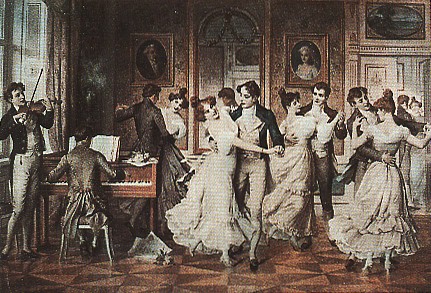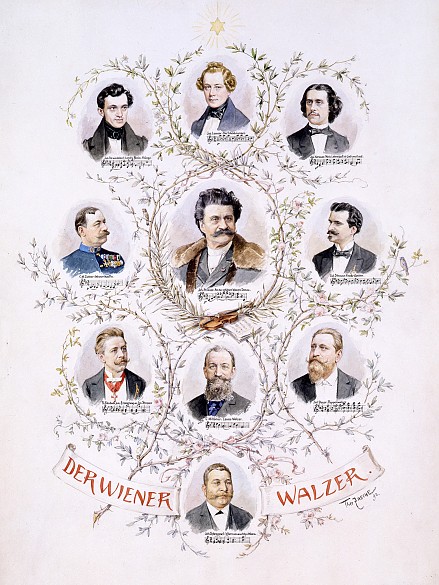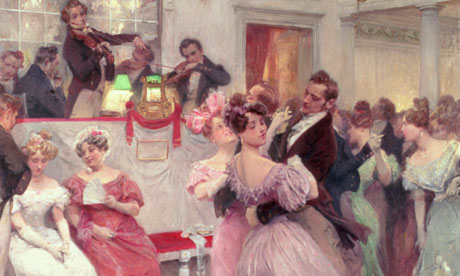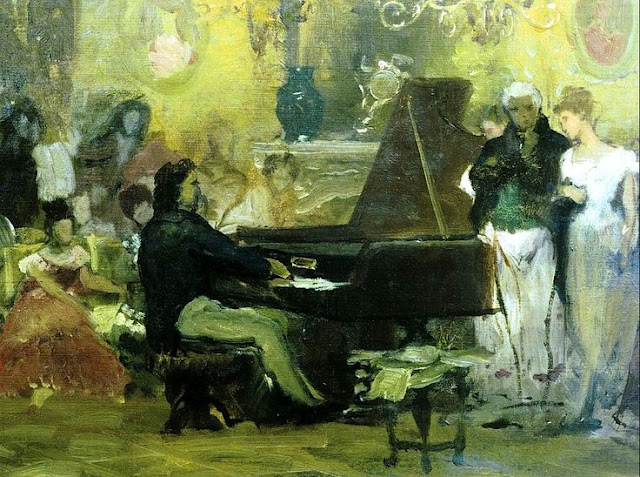"I can't understand why people are frightened
of new ideas. I'm frightened of the old ones."
AUTHOR: John Cage

MEANING OF THE QUOTE:
"To continue to grow as a human being you must be
open to try new ideas otherwise you stagnate."

MEANING OF THE QUOTE:
"To continue to grow as a human being you must be
open to try new ideas otherwise you stagnate."
COMPOSER:
FREDERIC CHOPIN

WALTZ NO. 1 IN E-FLAT MAJOR
GRANDE VALSE BRILLANTE
OP. 18, NO.1

WALTZ NO. 1 IN E-FLAT MAJOR
GRANDE VALSE BRILLANTE
OP.18, NO.1
Sergei Rachmaninoff, Piano
WALTZ NO. 1 IN E-FLAT MAJOR
GRANDE VALSE BRILLANTE
OP. 18, NO.1
Leonard Pennario, Piano

WALTZ NO. 1 IN E-FLAT MAJOR
GRANDE VALSE BRILLANTE
OP.18, NO.1
Valentina Lisitsa, Piano
GRANDE VALSE BRILLANTE
OP.18, NO.1
Valentina Lisitsa, Piano
A German country-dance
in origin, (e.g. the ländler)
in origin, (e.g. the ländler)
 |
| Ländler |
at the beginning of the 19th century
becoming extremely fashionable,
becoming extremely fashionable,
flourishing among the aristocratic world
invading the ballroom and later the
ballet, and opera house in spite of the
warnings of doctors and moralists (even
under the objection of Lord Byron)
who feared that the dance
promoted physical and spiritual
degeneration. It was considered
very risqué and indecent by them
due to the closed hold and all the turning
promoted physical and spiritual
degeneration. It was considered
very risqué and indecent by them
due to the closed hold and all the turning
in the dance steps. The dance was even
forbidden in some countries and
various religious groups.

Later, with the work of composers like
Chopin, the waltz was transformed into
A salon is a gathering of people under the
roof of an inspiring host, held partly to
amuse one another and partly to refine
the taste and increase the knowledge of
the participants through conversation.
The waltz, in the concert hall, was to undergo
 |
| Rudolf Alfred Höger: Hausmusik |
another apotheosis under the symphonies
of Bruckner, Mahler, Tchaikovsky, and in
the evocative choreographic poem of
Ravel, La Valse. Mozart and Haydn (plus
many others) had earlier been commission-
ed to write waltzes for royal balls but the
elevation of the waltz from rusticity to
art was boosted in the 1820's
and Johann Strauss I
 |
Theodor Zasche: The Viennese Waltz, 1892
From upper left to lower right: Johann Strauss I, Joseph Lanner,
Josef Strauss, Carl Michael Ziehrer, Johann Strauss II, Eduard Strauss,
Philipp Fahrbach II, Carl Millöcker, Josef Bayer, Johann Schrammel.
|
(the Strauss family), early contemporaries
of Chopin who he encountered while staying
in Vienna. By the time Chopin arrived in Paris,
after spending his childhood and teen years
in Poland, the waltz was already hugely popular.


The waltz's standard structure comprised
an introduction, a half-dozen or so melodies,
and a coda that recapped them.


There were two primary national waltz styles
that emerged: Viennese and French. The
French consisted of three complementary
dances of increasing vigor, performed with
much leaping and springing, while the
Viennese held to a single underlying tempo
and a constant rotating glide. The distinctive
accompaniment invariably finds one chord
per three-beat measure, with the bass note
on the downbeat and the remainder of the
chord on the second and third beat.
| The Basic Waltz Rhythm |
By 1819 waltzes were being published as
independent piano pieces, not necessarily
tied to dancing. Particularly influential were
the waltzes of Carl Maria von Weber's
"Invitation to the Dance" of that same year
 |
| Carl Maria von Weber |
and Franz Schubert,
 |
| Franz Schubert |
published in 1821 and 1830.
The transference of the waltz
from the dance floor
from the dance floor
and concert music opened up new and
freer possibilities for Chopin, who was
able to maintain the general character-
istics of the genre while incorporating a
more aristocratic tone, a variety of moods,
and pianistic virtuosity, unconstrained by
the requirements of actual dancing.




Frédéric Chopin’s Waltzes are pieces of
moderate length adhering to the traditional
3/4 waltz time, but are remarkably different
from the earlier Viennese waltzes in that
they were not designed for dancing but for
concert performance (the salon-type waltz
which could be limited to a performance
in a small room, provoking intimacy and
nostalgia). Some of them are accessible by
pianists of moderate capabilities, but the more
difficult of them require an advanced technique.




The published waltzes of Frédéric Chopin
(actually valses; a subtle but significant
stylistic distinction) fall into two distinct
categories: sparkling, highly ornamented
jewels suitable, to at least some degree, for
actual ballroom use; and more introspective,
often rather melancholy, miniatures that are
far removed from the fashionable Viennese
waltzes. The earliest of the published waltzes,
the Grande Valse brillante in E Flat Major,
Op. 18, is an example of the former.

Major, Op. 18, written in 1833 at the
age of 23 and published one year later,
was the first of eight waltzes for solo
piano that Chopin himself authorized for
publication, although prior to 1834 he had
written at least sixteen waltzes that were
either destroyed or eventually published

sister of Emma, to whom
Chopin dedicated another work: the
VARIATIONS BRILLANTES, OP. 12
IN B-FAT MAJOR
Vladimir Ashkenazy, Piano
it is one of his most
popular and glittering pieces.

Carl Maria von Weber
AUFFORDERUNG ZUM TANZ OP. 65
(INVITATION TO THE DANCE)
Hector Berlioz, Orchestrator
Kurt Eichhorn, Conductor
Münchner Rundfunkorchester
AUFFORDERUNG ZUM TANZ OP. 65
(INVITATION TO THE DANCE)
Hector Berlioz, Orchestrator
Kurt Eichhorn, Conductor
Münchner Rundfunkorchester
(INVITATION TO THE DANCE)
Alicia de Larrocha, Piano (1964)
because in it Chopin followed Weber's
musical structure; the announcement section being
followed by various themes and a coda in stretto.


musical structure; the announcement section being
followed by various themes and a coda in stretto.


This piece is a compelling ten-minute portrait of
a diffident girl swept up in the exhilaration of the
waltz amid episodes of more relaxed introspection,
and finally left alone to ponder her memories.
a diffident girl swept up in the exhilaration of the
waltz amid episodes of more relaxed introspection,
and finally left alone to ponder her memories.
With this waltz Chopin embraced the refined
lightness and aristocracy of intimate salon
music while keeping with the original atmos-
pheric and dance conventions without sacrific-
ing artistic quality. Chopin also gave the title
"Grand Valse Brillante" to the next three
waltzes in the Op. 34 set published in 1838.

dancing, this waltz was used in the closing
of the ballet Chopiniana (1908).
of the ballet Chopiniana (1908).

CHOPINIANA
Part 1
Part 1
Kirov Ballet 1991:
Asylmuratova, Zaklinsky, Pankova, Polikarpova
Asylmuratova, Zaklinsky, Pankova, Polikarpova
 |
| Zinaida Serebriakova: Girls Sylphides (Ballet Chopiniana) |
Les Sylphides (a short, non-narrative ballet blanc)
originated when the great reformer of the ballet,
choreographer Michel Fokine,


was introduced to an orchestrated version of a series
of piano pieces of Chopin by the Russian composer
of piano pieces of Chopin by the Russian composer
which he felt could perfectly serve the demands
of dance. Asking Glazunov to work with
him he created this ballet premiering it in 1907
at the Mariinsky Theatre
 |
|
Opened in 1860, the preeminent theatre (opera and ballet) of late 19th c. Russia.
It was named "Mariinsky" after its Imperial patroness, Empress Maria
Alexandrovna, wife of Alexander II. The center "Tsar's Box" was where the
Emperor and his family always sat when attending performances.
|
Ballet sur la musique
de Chopin. This formed
the basis of the ballet,
Chopiniana,
The second version was performed
March 21, 1908, again at the Mariinsky
Theatre in St. Petersburg
by the Imperial Ballet
with solos danced by Pavlova,


Anna Pavlova
Karsavina, Nijinsky, and Preobrajenska.



Chopiniana premiered as Les Sylphides
as its soloists were again, Tamara Karsavina
 |
| Savely Sorin: Tamara Karsavina in Les Sylphides, 1910 |
and Vaslav Nijinsky (as the poet, dreamer, and young man),


Left: Nijinsky in Les Sylphides
Right: Nijinsky Colorized Photograph
 |
This new title paid homage to La Sylphide, the famous ballet of 1832,
which marked the birth of the Romantic movement in the world of
dance. As specified the program, Les Sylphides was a
"romantic dream" with no plot; just a series of choreographic
pictures for a dance troupe and four soloists
|
including the dancers Anna Pavlova and Alexandra Baldina.
 |
| Jules Léon Flandrin: Pavlova and Nijinsky, 1909 |
 |
| Alexandre Benois: Set model for Les Sylphides, 1909 |


1. Polonaise in A major
(some companies substitute Prelude in A Major instead)
2. Nocturne in A flat major (Op. 32, no. 2)
3. Valse in G Flat major (Op. 70, no. 1)
4. Mazurka in D major (Op. 33, no. 2)
5. Mazurka in C major (Op. 67, no. 3)
6. Prelude in A major (Op. 28, no. 7)
7. Valse in C sharp minor (Op. 64, no. 2)
8. Grande Valse in E flat major (Op. 18, no. 1)

CHOPINIANA
Part 2
Part 2
Kirov Ballet 1991:
Asylmuratova, Zaklinsky, Pankova, Polikarpova
Asylmuratova, Zaklinsky, Pankova, Polikarpova
This piece was retained in it successor,
Sergei Diaghilev's ballet called
in which Diaghilev,
 |
| Valentin Serov: Portrait of Sergei Diaghilev |
commissioned several Russian composers
to orchestrate Chopin's piano music.


Although these ballets were set to
orchestrations of Chopin's music, waltz
steps were never used in the choreography.

Les Sylphides
was a 'romantic reverie' ballet
in which white-clad sylphs

was a 'romantic reverie' ballet
in which white-clad sylphs

(wearing filmy skirts, with garlands in their
hair and little wings on their backs)
 |
| Marie Taglioni in the Original "La Sylphide" (the "namesake" of Les Sylphides) Marie was the first to integrate pointe work into performance;
the tutu was created to expose her footwork.
|

dance with a young man
in the moonlight. To this ballet,
the composer Igor Stravinsky
 |
| Igor Stravinsky |
contributed his own orchestral arrangements
of Chopin's Nocturne in Ab and for the
finale, Waltz No. 1 in E-Flat Major.
The famous English composer,
Benjamin Britten,

Benjamin Britten
accepted a commission to orchestrate
a new version of "Les Sylphides"
for the Ballet Theater in New York during
the early years of World War II. His
sequence of orchestrated Chopin piano
pieces (Preludes, Nocturnes, Mazurkas,
etc.) also concludes with the
"Grande Valse Brillante."
WALTZ NO. 1 IN E-FLAT MAJOR
GRANDE VALSE BRILLANTE
Op. 18, NO.1
Britten's Orchestration
from the ballet 'Les Sylphides'
Joseph Levine, Conductor
Ballet Theatre Orchestra
Britten's Orchestration
from the ballet 'Les Sylphides'
Joseph Levine, Conductor
Ballet Theatre Orchestra

in November, 1830 at the age of 20 to
establish his career in the fabled city of
Mozart, Beethoven, and Schubert,
Chopin was desperate to escape the
political turmoil of his native Poland.

Although he remained in Vienna for eight
months, he and the city never took to each
other as he had hoped so he moved the
following year to Paris, a city he found
much more congenial. Though in Vienna
just a short time he was not immune to the
charm of the waltzes he heard there that were
so popular in that city. Chopin wrote home
from Vienna in 1830-31, marveling at the
"terrific applause"
garnered by the Viennese waltzes of
Strauss and Lanner, yet citing
them as evidence of the public's
"corrupt taste"
and entirely foreign to his nature,
declared, upon his return to Paris, that
"I am still unable to play valses."
He lamented that,
"Lanner, Strauss and their
waltzes obscure everything."
Yet, the structure of his own first published
waltz, which he entitled "Grand Valse
brilliante," closely adhered to the style he
claimed to deplore; a style that, arguably
danceable, is grand and brilliant (foot-
tapping, energetic, humorous in places and
lyrical) just as true Viennese style salon music.
 |
Salon Music Performance
James Tissot: The Concert, 1875
|
Chopin had reinvented the Viennese waltz
form in his own image, transforming it into
something altogether sublime, adding refine-
ment, nuance and reflection more suited
to aristocracy than the masses and for
private sittings than the ballroom.
 |
Salon Music Performance
The imagined gathering shows seated Alfred de Musset or Alexandre Dumas, père,
a portrait of Byron on the wall, a statue of Joan of Arc on the far left.
|
The Grande Valse Brillante Op. 18 written
when Chopin, as a young composer, was
in a particularly extroverted mood during a
very prolific summer that saw Chopin move
to a new stylish apartment in Paris,
in rue de la Chaussée d'Antin.
 |
| A Colorized Old Postcard of Chaussée d'Antin |
This composition was probably
inspired by Weber's waltz, "Invitation
to the Dance," because it shares the same
grandeur, and recurring refrain as the earlier
work) opens with a brief introductory invitation
fanfare (a standard functional device of
the time to draw dancers' attention) with a
rhythm consisting of a single B-flat very much
like a bugle call (sort-of a "call to order")
| The opening fanfare of Op. 18 -- note the unusual fingering |
that coalesces into ¾ time
vigorous opening dance.
 |
| The opening melody of Op. 18 |
This opening episode is followed by a
medley of seven subordinate and con-
trasting waltz tunes, alternately lyrical
and brilliant. Each of the dance
themes brings a different melodic
character and dance motion.


The Waltz in E-flat Major is sectional in
structure and can be analyzed with a
schematic outline. Assigning a letter to
each distinct 16-bar melody, would read:


The Waltz in E-flat Major is sectional in
structure and can be analyzed with a
schematic outline. Assigning a letter to
each distinct 16-bar melody, would read:
A (2x), B, A, B, C (2x), D, E, F (2x), G, F, G, F, H,
a bridge to reassert the rhythm, A, B, A (interrupt-
ed by two pauses), four bars of bass rhythm, and
then a coda combining fragments of B, G and A,
followed by A that dissolves into scalar elaborations
accompanied by a gradual increase in tempo which
reaches a peak at the upper ranges of the keyboard
then slows down and fades to give way to a massive
series of dramatic fortissimo cadential chords.
A typical performance of this music
is about five minutes in length.

 |
| Autograph of the Second Version of the Composition P. 1 |

LINKS
http://en.wikipedia.org/wiki/Grande_valse_brillante_in_E-flat_major_(Chopin)
http://en.wikipedia.org/wiki/Waltzes_(Chopin)
http://imslp.org/wiki/Grande_valse_brillante,_Op.18_(Chopin,_Fr%C3%A9d%C3%A9ric)
http://www.allmusic.com/composition/waltz-for-piano-no-1-in-e-flat-major-op-18-ct-207-mc0002368706
https://musopen.org/sheetmusic/146/frederic-chopin/waltz-in-e-flat-major-grande-valse-brillante-op-18/
http://www.answers.com/topic/waltz-for-piano-no-1-in-e-flat-major-op-18-ct-207
http://www.pianostreet.com/amember/signup_lp4-1.php?ad=piecepage&preview=chopin_waltz_op18
http://www.free-scores.com/download-sheet-music.php?pdf=3402
http://www.free-scores.com/PDF_EN/chopin-frederic-waltz-op-18-grande-valse-brillante-3402.pdf
http://en.chopin.nifc.pl/chopin/composition/detail/id/63
http://www.hyperion-records.co.uk/al.asp?al=CKD248
http://www.flutetunes.com/tunes.php?id=760
http://kreusch-sheet-music.net/noten/KSM_FredericChopin_Walzer_Nr._18-BI62_33114.pdf
http://www.msrcd.com/catalog/cd/MS1133
http://www.classicalconnect.com/Piano_Music/Chopin/Grande_Valse_Brillante/816
http://cantorion.org/music/539/Grande-Valse-Brillante-Original-version
http://sheetmusicpoint.com/composer/c/chopin/piano/waltzes/schirmer-joseffy/chopin-grande-valse-brillante-op-18.pdf
http://www.naxos.com/mainsite/blurbs_reviews.asp
http://en.wikipedia.org/wiki/Grande_valse_brillante_in_E-flat_major_(Chopin)
http://en.wikipedia.org/wiki/Waltzes_(Chopin)
http://imslp.org/wiki/Grande_valse_brillante,_Op.18_(Chopin,_Fr%C3%A9d%C3%A9ric)
http://www.allmusic.com/composition/waltz-for-piano-no-1-in-e-flat-major-op-18-ct-207-mc0002368706
https://musopen.org/sheetmusic/146/frederic-chopin/waltz-in-e-flat-major-grande-valse-brillante-op-18/
http://www.answers.com/topic/waltz-for-piano-no-1-in-e-flat-major-op-18-ct-207
http://www.pianostreet.com/amember/signup_lp4-1.php?ad=piecepage&preview=chopin_waltz_op18
http://www.free-scores.com/download-sheet-music.php?pdf=3402
http://www.free-scores.com/PDF_EN/chopin-frederic-waltz-op-18-grande-valse-brillante-3402.pdf
http://en.chopin.nifc.pl/chopin/composition/detail/id/63
http://www.hyperion-records.co.uk/al.asp?al=CKD248
http://www.flutetunes.com/tunes.php?id=760
http://kreusch-sheet-music.net/noten/KSM_FredericChopin_Walzer_Nr._18-BI62_33114.pdf
http://www.msrcd.com/catalog/cd/MS1133
http://www.classicalconnect.com/Piano_Music/Chopin/Grande_Valse_Brillante/816
http://cantorion.org/music/539/Grande-Valse-Brillante-Original-version
http://sheetmusicpoint.com/composer/c/chopin/piano/waltzes/schirmer-joseffy/chopin-grande-valse-brillante-op-18.pdf
http://www.naxos.com/mainsite/blurbs_reviews.asp
item_code=8.550365&catNum=550365&filetype=About%20this%20Recording&language=English#
http://www.russianballethistory.com/ballethistories.htm
http://www.southbendsymphony.com/mw2-program-notes.php
http://www.russianballethistory.com/ballethistories.htm
http://www.southbendsymphony.com/mw2-program-notes.php
 |
| http://www.refinandonuestrossentidos.com/fr%C3%A9d%C3%A9ric-chopin/valses/ |
 |
| Philippe Jacques Linder: Waltz at the Bal Mabille |
Poem by
Hermann Hesse


A dance of Chopin bursts into the room,
a frantic, unleashed dance,
The windows reflect stormy air,
a withered crown adorns the piano.
The piano you, violin I,
so we play and we do not end ever
and anxious waiting, you and I,
Who will break the spell first.


Who will stop first in the middle of the rhythm
and push away from the lights themselves,
and who will make the first question
to which there is no answer.
By Sagittarius
Herman Hesse, Lyrics
https://www.youtube.com/watch?v=Vrbef7Vv4ow

https://www.youtube.com/watch?v=Vrbef7Vv4ow

HAIKU
Chopin's Valse Brillante
is a grand waltz for dancing
in a giant ballroom.































